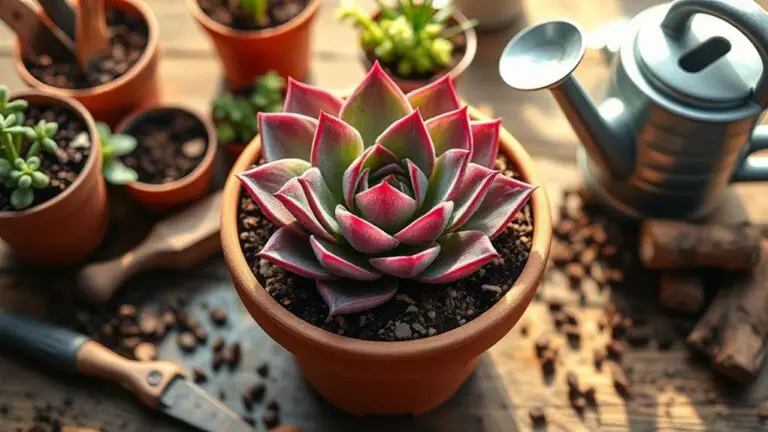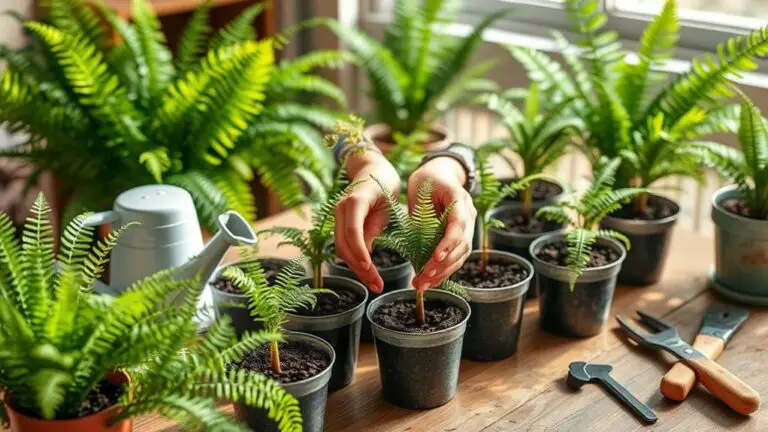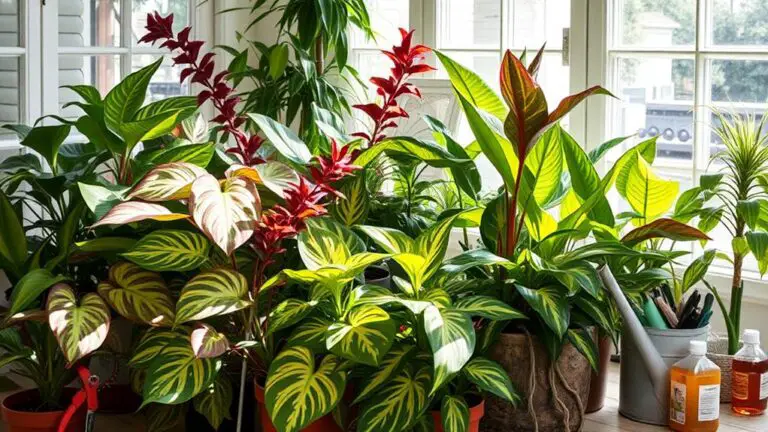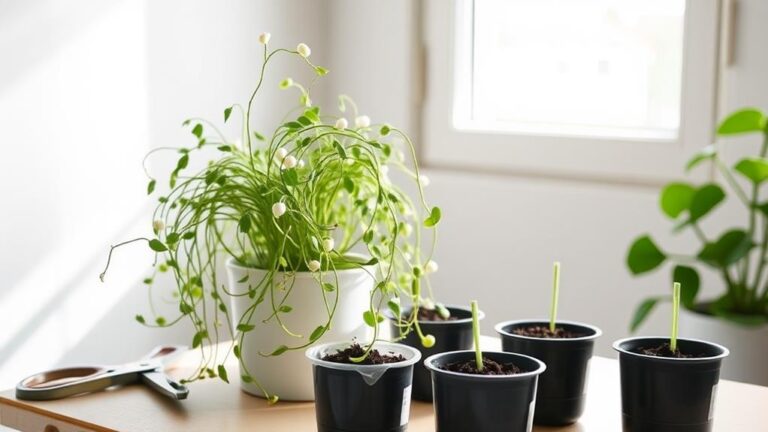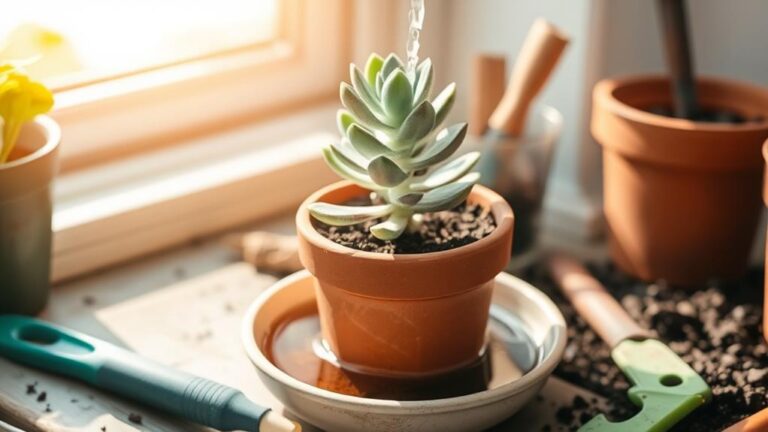7 Easy Tips for Growing Succulents for Beginners
If you're new to growing succulents, starting off on the right foot can make all the difference. By selecting easy-care varieties and understanding their specific needs, you'll find that these resilient plants can thrive with minimal effort. From choosing the right soil mix to mastering proper watering techniques, each step plays an important role in ensuring your succulents stay healthy. But what's the best way to provide them with adequate light and maintain ideal temperatures? Let's explore these essential tips to help you cultivate vibrant and robust succulents effortlessly.
Choose the Right Succulents

Choosing the right succulents is essential for guaranteeing your plants thrive, especially if you're just starting out. When you choose the right succulents, you set yourself up for success. Beginner-friendly varieties like Haworthia, Senecio String of Pearls, and Donkey Tail are easy to care for and resilient.
Most succulents love full sun, needing at least four to six hours of sunlight daily. This is important, especially if you're growing them indoors. But not all succulents are the same. Some, like Haworthia, can tolerate low light conditions. Understanding the growing conditions of your chosen plants is key.
If you're looking to plant outdoors, consider Sempervivum and Cactus. These varieties of succulents are hardy and can handle harsh conditions. Sempervivum, for example, can withstand temperatures as low as -30°F, making it perfect for colder areas.
Always think about your local climate when selecting succulents. Research specific types to guarantee they match your environment. Confirm your pots have drainage holes and use well-draining soil to keep your plants healthy.
With the right choices, your succulents will thrive and bring joy to your space.
Proper Watering Techniques

Once you've chosen the right succulents for your environment, understanding proper watering techniques is the next essential step in guaranteeing their health. Succulents need the right amount of water to thrive, and overwatering is a common mistake. To start, only water your succulents when the top inch of soil feels completely dry, typically every 10-14 days.
Using the "soak and dry" method guarantees that your succulents get enough moisture without sitting in water. This involves thoroughly watering the soil until it drains from the bottom. Proper drainage is vital to prevent excess water from causing root rot. Always use room temperature water to avoid shocking the plants.
Here's a quick guide to help you:
| Step | What to Do |
|---|---|
| 1. Check Soil | Use a moisture meter or chopstick. |
| 2. Water | Apply the "soak and dry" method. |
| 3. Drain | Guarantee excess water is removed from saucers. |
Allow the soil to dry completely between waterings to support healthy root respiration. Removing any excess water from saucers beneath pots also helps prevent overwatering and fungal issues. Follow these tips to keep your succulents happy and healthy!
Select Breathable Pots

Selecting the right pots for your succulents is vital for their well-being. One key factor is choosing a breathable pot. Terracotta pots are a great choice because their porous nature allows for excellent airflow, keeping the roots healthy. They also help moisture evaporate, which is important for preventing root rot.
Make certain the pots you choose have drainage holes. This is significant because it lets excess water escape, guaranteeing the potting soil doesn't stay too wet. Succulents don't like having their roots sitting in water, and good drainage helps keep them happy.
If you use containers without drainage, like some glass terrariums, you risk waterlogging your plants, leading to unhealthy roots.
You can also look for pots made from materials like ceramic or breathable plastic. These options provide good airflow to the roots while maintaining a healthy moisture balance.
Repotting your succulents every 1-2 years is a good practice. This refreshes the potting soil and guarantees that the medium remains well-draining.
Use Suitable Soil Mix

When growing succulents, using a suitable soil mix is vital for their health and growth. Unlike normal potting soil, a well-draining soil mix specifically formulated for succulents is essential. Regular potting soil retains too much moisture, which can lead to root rot—a common issue that can harm your plants.
A good succulent soil mix typically combines potting soil, sand, and either perlite or pumice. This blend enhances drainage and aeration, allowing the roots to get enough oxygen. Aim for a soil composition that's at least 60% nonorganic material. This mix guarantees healthy succulents by preventing excess moisture from lingering around the roots.
You can easily find commercially available succulent soil mixes, like Espoma's Cactus Mix, designed to provide ideal drainage. These mixes take the guesswork out of creating the right soil balance yourself.
Don't forget to regularly check the condition of your soil and renew it every 1-2 years. Over time, soil can compact and lose its drainage properties. Revamping the soil helps maintain the nutrients and drainage necessary for your succulents' growth.
Ensure Adequate Light

Besides using the right soil, guaranteeing your succulents get adequate light is just as important. Succulent plants need at least 4-6 hours of sunlight daily to thrive.
While many varieties do best in bright, indirect light, placing them in full shade or under insufficient light conditions can cause problems. You might notice stretching leaves and weak growth if your succulents aren't getting enough light, indicating they need a sunnier spot.
To keep your succulents healthy, monitor their light exposure closely. Here are some tips to guarantee they get the right amount of light:
- Bright, Indirect Light: Place your succulents in a spot where they receive bright, indirect light. Direct sunlight can burn the leaves.
- Signs of Insufficient Light: Watch for stretching leaves or weak growth. These are signs your plant needs more light.
- Rotate Weekly: Rotate your succulents every week to guarantee even light exposure, promoting balanced growth.
- Use Grow Lights: If you're growing succulents indoors with low natural light, consider using grow lights to supplement sunlight.
Maintain Optimal Temperature
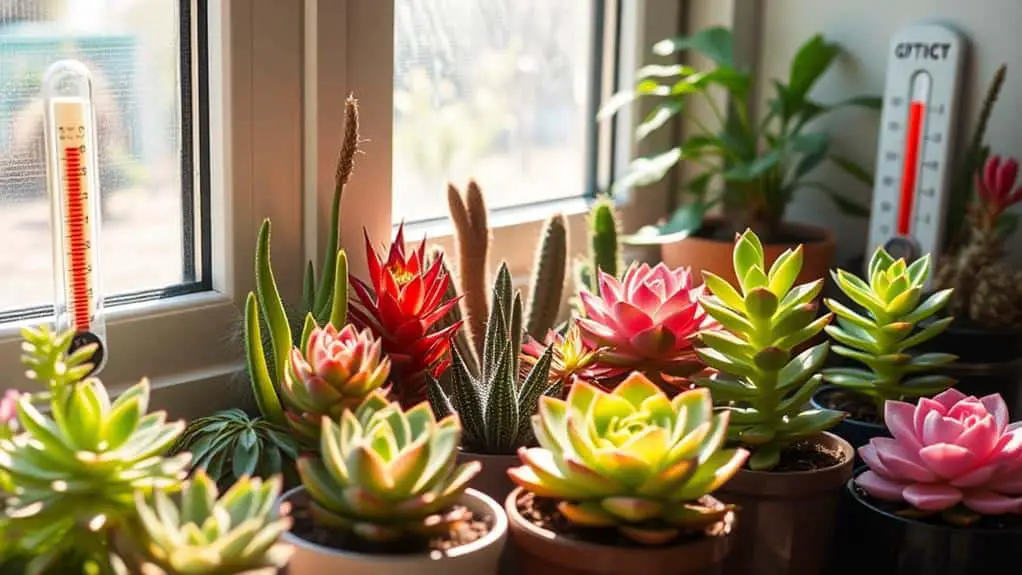
Maintaining ideal temperature is vital for the health of your succulents. These resilient plants thrive in temperatures between 60°F and 80°F (15°C – 27°C). To guarantee peak growth, keep your succulent plants within this range as much as possible.
It's essential to protect succulents from frost since most aren't frost-tolerant and can suffer damage below 40°F (4°C).
If you're moving your succulents outdoors, remember to acclimatize them gradually to avoid sunburn, especially if they've been indoors. Sudden exposure to direct sunlight and temperature changes can harm them.
Succulents prefer dry air, so keep them away from heating vents or air conditioning units that can cause temperature fluctuations. These quick changes can stress the plants.
Be diligent and monitor temperature changes with the seasons. In winter, you might need to bring your plants indoors or provide extra protection. During the summer, adjust their care to handle the heat.
As indoor plants, succulents can be sensitive, so always guarantee they're in a stable environment. With a little attention to these details, your succulents will stay healthy and thrive beautifully.
Regular Plant Grooming

Regular plant grooming is vital to keep your succulents vibrant and healthy. By dedicating a little time to regular plant grooming, you can guarantee your succulents thrive. Here's how you can do it:
- Remove dead or decaying leaves: These can attract pests and make your plant look messy. Regularly check your succulent and gently pull away any dead leaves.
- Inspect the roots: Periodically examine the roots for signs of overwatering or rot. A healthy root system is essential for your succulent's overall health.
- Dust leaves gently: Use a damp cloth to wipe off dust from the leaves. This helps enhance photosynthesis and keeps your plant looking its best.
- Trim damaged leaves: Snip off any damaged or unhealthy leaves to promote new growth and keep your succulent clean and tidy.
Maintaining a clean environment around your succulents is also key. It helps deter insects and other pests that may harm your plants.
Keeping the area around your succulents free from debris and fallen leaves can prevent pests from making a home there.
Frequently Asked Questions
What Is the Secret to Growing Succulents?
The secret to growing succulents is using well-draining soil and watering only when the soil is dry. Make certain they get bright, indirect sunlight for 4-6 hours daily and use breathable pots. Regular grooming also helps.
How to Grow Succulents for Beginners?
Choose easy succulents like Haworthia. Give them 4-6 hours of sunlight daily. Water only when soil's dry, use well-draining soil, and pots with drainage holes. Check for pests and fertilize lightly during the growing season.
Should You Mist Succulents?
No, you shouldn't mist succulents. They thrive in dry conditions and absorb moisture through their roots. Instead, water them thoroughly when the soil is dry. If indoor humidity is low, use a nearby humidity tray.
Do Succulents Root Better in Water or Soil?
Succulents root better in soil than water. Use a well-draining mix with perlite or sand. Allow cuttings to callous before planting to prevent rot. Soil-grown roots are stronger, ensuring healthier plants. Keep them in bright, indirect light.
Conclusion
You've got this! Growing succulents is easier than you think. By choosing the right varieties, watering correctly, and using breathable pots with suitable soil, you're already on the path to success. Don't forget to give them plenty of light, keep them at the right temperature, and groom them regularly. Follow these simple tips, and you'll have healthy, vibrant succulents in no time. Happy gardening and enjoy watching your plants thrive!


